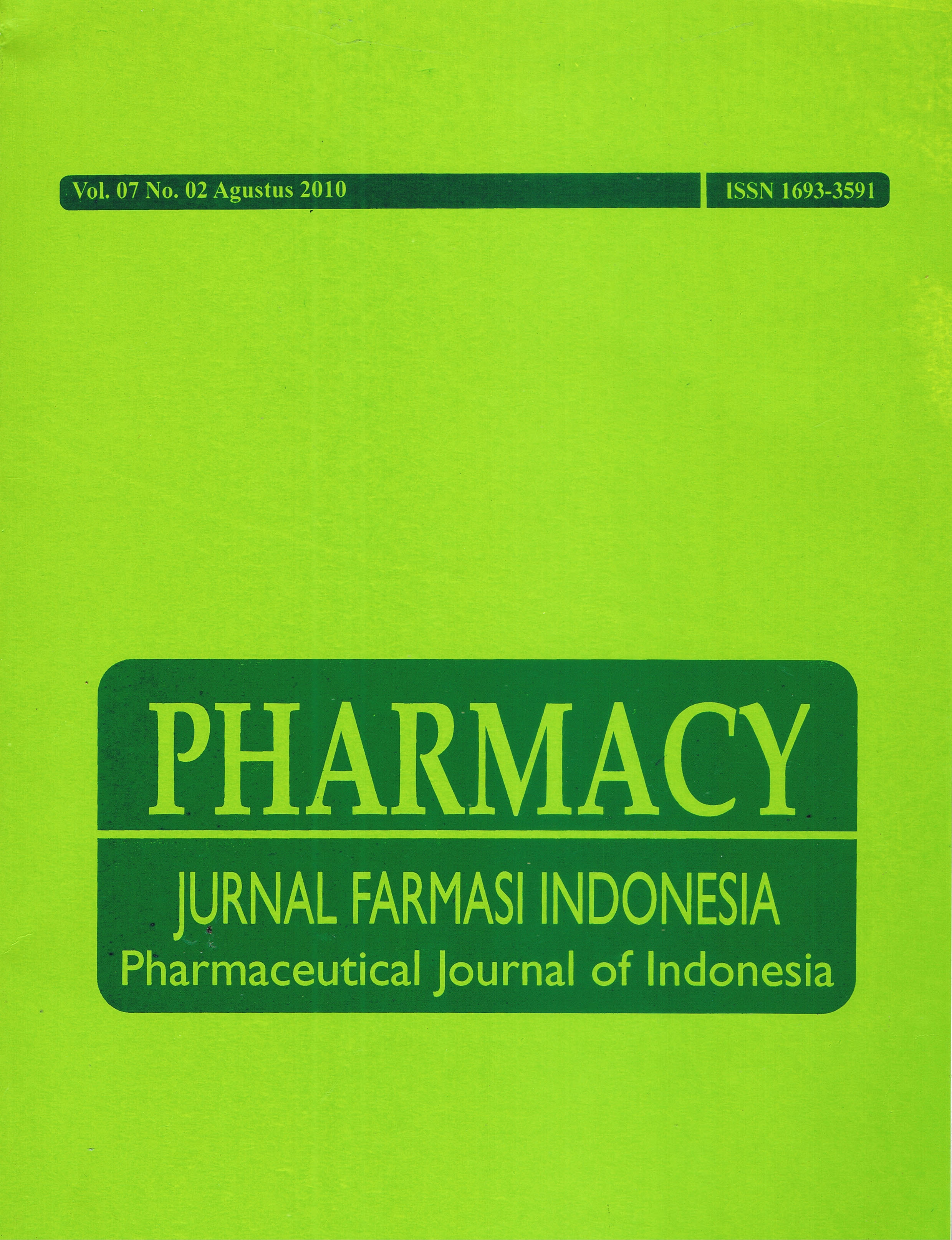KURKUMINOID, PENETAPAN KADARNYA PADA JAMU SERBUK TEMULAWAK (Curcuma xanthorriza Roxb) SECARA SPEKTROFOTOMETRI ULTRAVIOLET-VISIBEL
DOI:
https://doi.org/10.30595/pharmacy.v7i1.566Abstract
ABSTRAK Telah dilakukan penelitian tentang penetapan kadar kurkuminoid dalam jamu serbuk “X” yang mengandung temulawak (Curcuma xanthoriza Roxb). Tujuan penelitian ini yaitu untuk mengetahui kadar kurkuminoid dalam jamu serbuk “X” yang diambil dari Purwokerto. Dalam penelitian ini, sampel diambil satu untuk diekstrak lalu direfluk dan penetapan kadar dilakukan menggunakan metode spektrofotometri Ultraviolet-Visibel. Reaksi kurkumin dengan penambahan asam borat dalam suasana asam membentuk komplek rubrocurcumin yang mengakibatkan pergeseran panjang gelombang maksimal kurkuminoid dari 420 nm sehingga panjang gelombang maksimalnya menjadi 500 nm. Hasil yang nilai KV pada uji presisi adalah 0,96% (<2%). Nilai persen perolehan kembali (recovery) rata-rata pada uji akurasi adalah 92,27%(80-120%). Linearitas ditunjukkan dengan nilai koefisien korelaso (r=0,95 > rtabel). Limit deteksi (LOD) dan limit kuantitasi (LOQ) yang diperoleh dari penelitian ini sebesar 0,08 ppm dan 0,25 ppm. Hasil penelitian ,menunjukkan kadar rata-rata kurkuminoid dalam jamu serbuk “X” sebesar 0,56 ppm. Berdasarkan hasil validasi tersebut maka metode spektrofotometri Ultraviolet-Visibe; dinyatakan valid. Kata kunci: kurkuminoid, Ultraviolet-Visibel spektrofotometri, jamu temulawak ABSTRACT It has been conducted a study on the determination of curcuminoid in jamu “X” powder containing rhizome of Curcuma xanthorrhiza Roxb, was distributed in Purwokerto. In this study, a sample was taken and extracted for determination of levels refluc and conducted using Ultraviolet Visible spectrophotometry method. Curcuminoid reaction with addition of boric acid in the atmosphere to form acids that leads to complex rubrocurcumin shift the maximum wavelength to 500 nm. The result study where coefficient of variation the presicion was 0.96 (<2%). The persen value of mean recovery at accuration the method were 92.27% (80-120%). Linearity showed with coefficient of correlation value (r-0.95 > r table). Limit of detection and limit of quantitation of this research was to 0.08 ppm and 0.25 ppm. The result showed that the mean concentration showed that the mean concentration of curcumin in jamu “X” powder containing rhizome of Curcuma xanthorrhiza Roxb. Sampel 0.56 ppm. Determination of curcuminoid in jamu “X” powder containing rhizome of Curcuma xanthorrhiza Roxb that use Ultraviolet Visible spectrophotometry method is valid. Key words: Curcuminoid, Ultraviolet Visible Spectrophotometry, jamu of temulawakReferences
Ansel, H.C., 1989, Pengantar Bentuk Sediaan Farmasi, Edisi IV, Universitas Indonesia, Jakarta
Dalimartha, S., 2000, Atlas Tumbuhan Obat Indonesia, Jilid II, Trubus Agriwidya, Jakarta, P 128
Depkes RI, 1985, Cara Pembuatan Simplisia, Depkes: Jakarta
Depkes RI, 2000, Parameter Standar Umum Ekstrak Tumbuhan Obat, Cetakan Pertama, Depkes RI: Jakarta
Kristina, N, N, 2007, Peluang Peningkatan Kadar Kurkumin Pada Tanaman Kunyit dan Temulawak Balai Penelitian Tanaman Obat dan Aromatik, http://balitro.litbang,deptan.go.id/pdf/edisi khusus/2007 hal 1,2-5
Rahmat dan Setianingrum, 2008, Pengaruh Ekstrak Temulawak Untuk Meningkatkan Nafsu Makan Pada Penderita Anoreksia Primer, Fakultas Kedokteran Universitas Diponegoro, Hal1.
Downloads
Published
How to Cite
Issue
Section
License
Authors who publish with this journal agree to the following terms:
- Authors retain copyright and grant the journal right of first publication with the work simultaneously licensed under a Creative Commons Attribution 4.0 International License that allows others to share the work with an acknowledgement of the work's authorship and initial publication in this journal.
- Authors are able to enter into separate, additional contractual arrangements for the non-exclusive distribution of the journal's published version of the work (e.g., post it to an institutional repository or publish it in a book), with an acknowledgement of its initial publication in this journal.
- Authors are permitted and encouraged to post their work online (e.g., in institutional repositories or on their website) prior to and during the submission process, as it can lead to productive exchanges, as well as earlier and greater citation of published work (See The Effect of Open Access).






